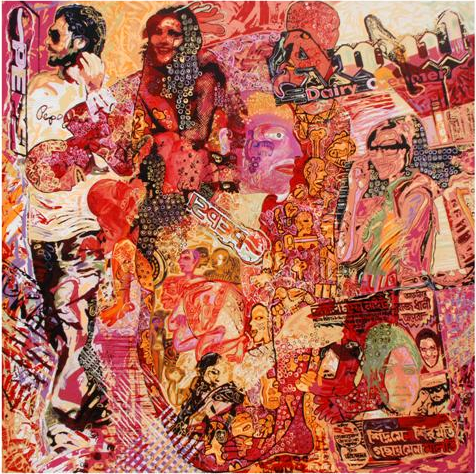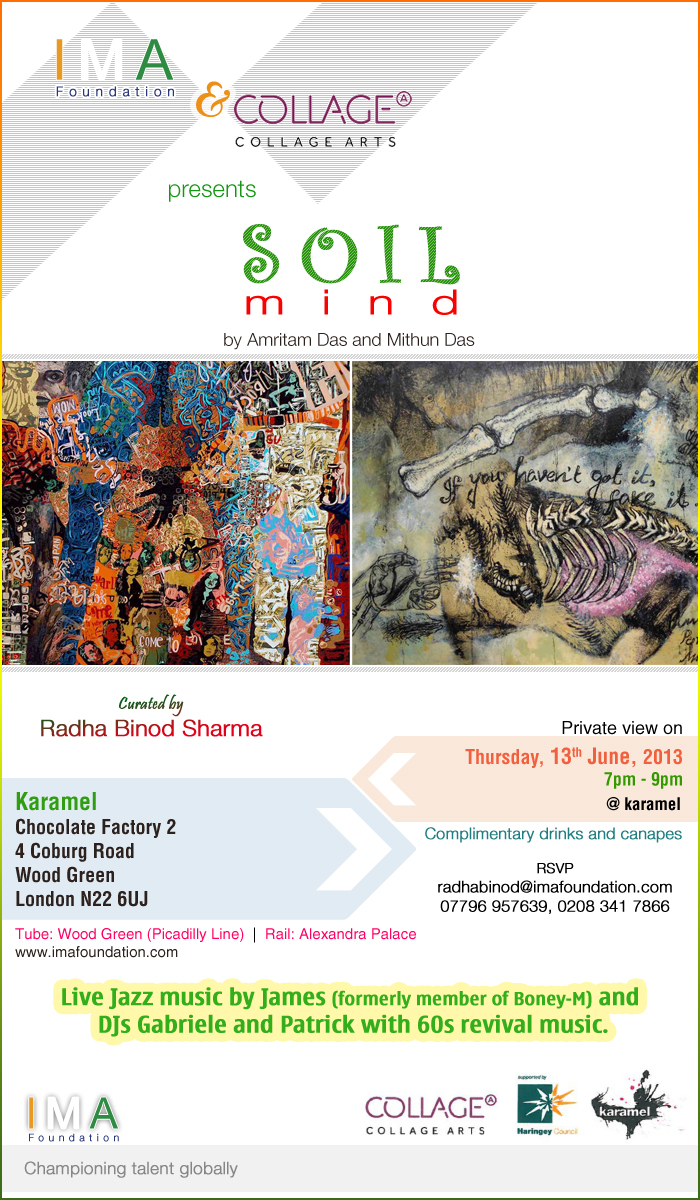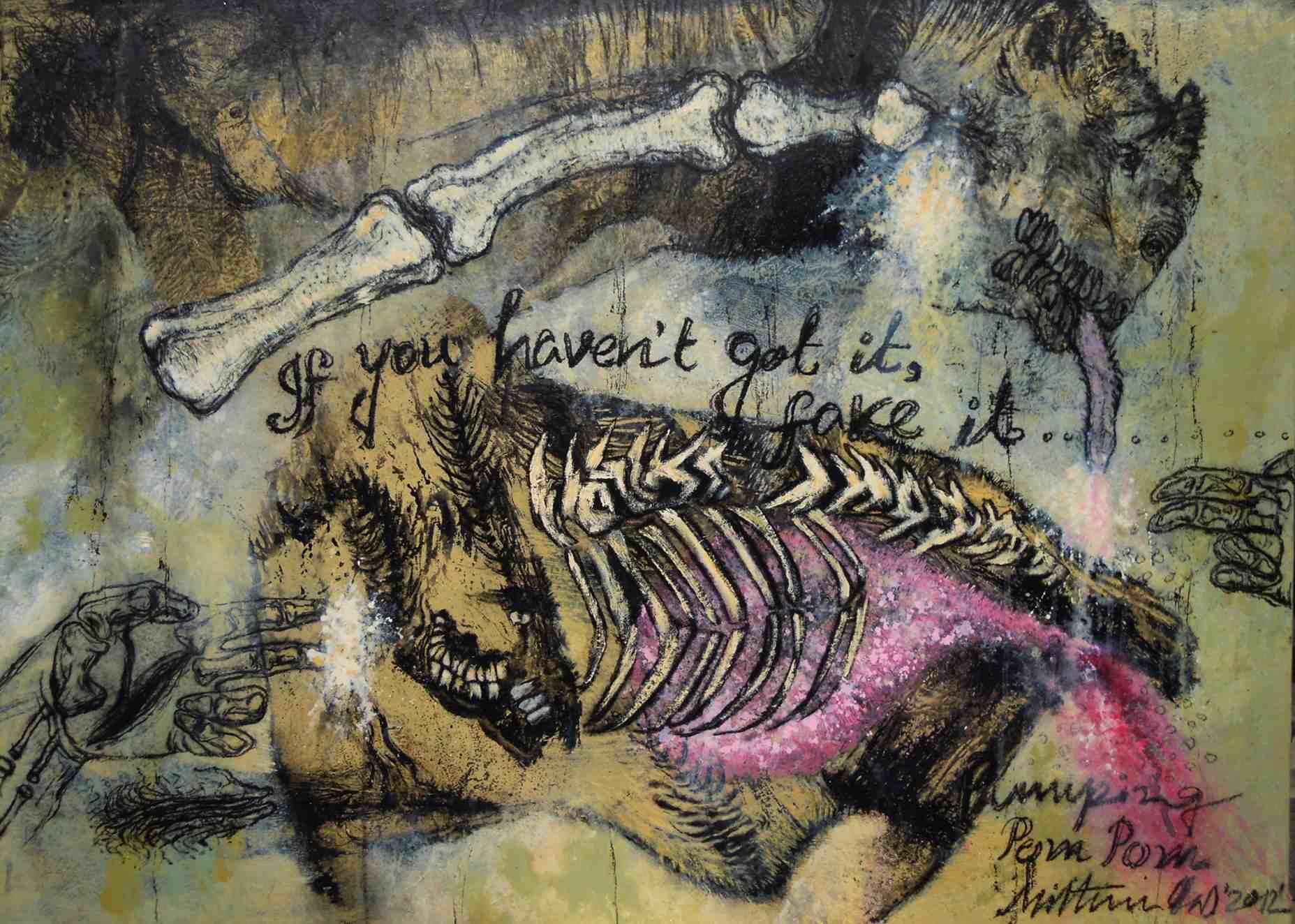
Exhibition of Soil Mind – June 2013
By Amritam Das and Mithun Das
Presented by Collage Arts in conjunction with IMA Foundation
Curated by Manoj Ambasna and Radha Binod Sharma
Continuing with our series of exhibitions showcasing the work of emerging talent from the Indian Sub-Continent, Collage Arts and IMA foundation are delighted to present Contradictions by Amritam Das and Mithun Das. Constantly fascinated by the interactions of humanity with itself and the world around it, both Amritam and Mithun offer a view of society that is both darkly comic and fatally serious; the ‘Contradiction’ of the show’s title. Through Mithun’s exposed skeletons and provocative suggestions of sexuality, and Amritam’s seemingly impenetrable, inter-textual layers we are presented with a glimpse inside the mind of the artists; an often unusual realm where one is bombarded with sensory information from all sides. Advertising, illustrations and all facets of pop culture have their place, as do organs, teeth and fragments of poetry, mingling to create a diverse collection, busy with the trappings of modern living. In this way, as well, there is something particularly Indian about the works. Amritam’s lively, multi-hued canvasses are evocative perhaps of Delhi or Bombay, where Western and Eastern commerce collide in a splash of symbols and pigments, while Mithun’s wry, eerie compositions seem primal and sparse in comparison, and much more redolent of the wild flora and fauna of his homeland. Each set of works clearly presents an idea of the contradictory nature of modern India, and leave the intrigued viewer with a veritable feast for their thoughts and senses.
Open at the Karamel, 4 Coburg Road, London N22 6UJ. Mon-Sat, 8am- 3pm. Private View on 13th June 2013 from 7-9pm

Collage Arts
Collage Arts is a leading cultural development organisation which manages the two Chocolate Factory buildings in Wood Green, North London. For over 25 years the organisation has remained committed to facilitating and improving access to the arts for the whole community and even further afield. Our recent collaboration with IMA Foundation has resulted in a series of exhibitions introducing the work of Indian artists to a UK audience.
IMA Foundation
IMA was established in 2008 with the intention of supporting emerging artists from the Indian sub-continent. Radha Binod Sharma art curator and artist himself has scoured India to identify top talent. He seeks to promote artists work through mentoring, exhibitions, and by providing financial support.
MITHUN DAS
It’s a phantasmagorical world in which Mithun Das seeks his solace. His works celebrates the uncanny, in his own personal way. The motifs which constantly recur in his images speak of the darkest desires as well as of unknown fears, which continues to haunt him. He constantly jostles with his own self in order to express his emotions through numerous agile charcoal marks on the surface. These marks not only decipher the tale of pleasure and pain but also narrate his dreams and nightmares. Death is probably the harshest reality of life. Such bereavement is hard to accept at times. For Mithun, all memories of personal loss find expression in his works. The horror of death disturbs him again and again, pushing him towards the unknown abyss. He renders his images spontaneously, creating impressions of his inner psyche. Signs of automatism are very strong in his works. His figures are neither dead nor alive. They constantly evolve from one form to the other, much like an unidentified metamorphosized creature. Human figures often appear grotesque, ghastly and obese, bearing scars from the past but appear content with lust and pleasure. They find their presence against the pale impasted layer of paint. At times their osseous structures are visible from their open wounds. His nudes do not illustrate the classical beauty rather attempt to represent the other realities. There is a subconscious urge to negate all set norms of beauty where he draws with his anxious graphic lines. Mutilated bodies and carcasses float around the surface and are randomly used as metaphors. Many of his images have a strong sexual overtone. He subtly plays with the erotic motifs as his paintings become a playground for both dead and alive. Sensuality is an integral part of his images. Oozing fluids from open wounds or transformed male phallus/female genitals teases our perception. The primitive urge finds mention much often. He further exaggerates certain visual sensation by introducing several paraphernalia within the image. His narratives revolve around private spaces where he questions and contests his own existence.
Soujit Das (Art Critic)
AMRITAM DAS
We all encounter innumerable images in our daily life, of which many leave an indelible mark in our memory. Amritam Das translates such experience on to his canvases along with impressions of his personal interaction. He borrows and absorbs images from his immediate surrounding and constructs narratives out of it. In this daily process of viewing many motifs from our environment fascinates us. We often tend to choose images which make a greater impact in our subconscious mind. Amritam excels in creating texture with such repertoire of images. He constantly engages in the act of documentation and all such images again get transformed on to his canvases. Thus personal and popular photographs, magazine cut-outs, local posters to logos of established brands all find their way in his works. He selects his images in a random fashion where they reveal themselves one by one in several layers. Sometimes it appears more like a riddle where the pleasure lies in solving it. It is the hidden image which provides the joy of discovery. One may find several disseminated self-contained figures on the surface engaged in soliloquy. Amritam manages to play with both crude and fine contours and balances his space with dexterity. The references/conflicts of urban as well as non-urban cultures could be easily noticed in his images. At places, he tends to make more personal statement, making the figures look naïve in character. The process of his works makes them more interesting. The colours for instance are used as private codes, prepared to decipher his unique artistic sensibility. Amritam constantly paints and erases images from his surface, superimposing them with a new layer of images which strikes his imagination. Every layer leaves some marks on the surface while new layers interact with the existing motifs. Multiple traces are left for the viewer to construct personal narratives. In our consumerist society, everyday new products are launched and old products become obsolete. Without much notice, we constantly accept the new and tend to reject the old. Amritam’s works do not deny the past rather in many cases they evolve as an archive of the popular. His forms floats freely on the surface while occasionally relating to each other. His paintings evolve as an acatalectic design. The array of vibrant colours and geometric motifs make his images look flamboyant.
Soujit Das (Art Critic)


